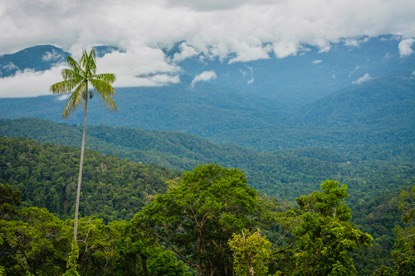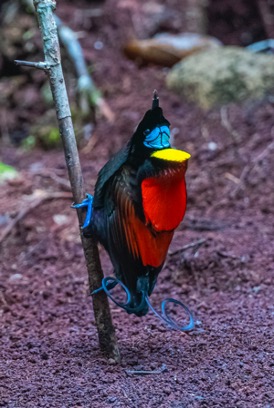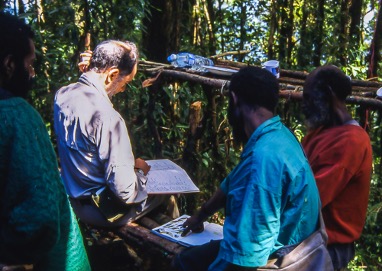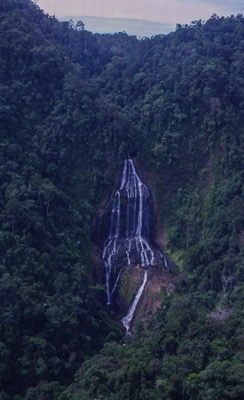Those halcyon days of ornithological expeditions to remote, undocumented locations are alive and well … as we can attest. We first began wading through mud, mosquitoes and spiny vine-thickets in our efforts to explore New Guinea as long ago as 1964 (JMD) and 1977 (KDB). New Guinea harbors one of the world’s most spectacular avifaunas – think Birds of Paradise. All in a landscape still covered in vast areas of primordial forest surmounted by hugely rugged mountains and even the odd tropical glacier.

This, then, is New Guinea – vast untouched forests from coast to mountain top, and huge expanses that are just waiting to be explored.
Our fieldwork has focused primarily on New Guinea’s outlying mountain ranges. Ten such ranges of varying height and extent, detached from New Guinea’s central cordillera, occur along the island’s northern reaches. As of 1964, only half had been ornithologically explored. The other five were remote and difficult to reach overland, three of them so remote that it would have been impossible to reach the summits except by helicopter, and even the locations and elevations of their highest peaks were unknown. Such islands in the sky represent an ideal situation for studying species distributions over isolated patches of habitat: why some species are much better colonists (present on more isolated patches) than other species. JMD began exploring the unexplored outliers in 1966, and we began exploring them together in 1990. We have now explored all ten (1, 2, 3, 4).
Each site presents its own special challenges in terms of access and surveying. While local people clearly know the birds of the area, we were the first professional western biologists, let alone ornithologists, to explore the Van Rees and Kumawa mountains, and possibly the first humans to set foot on their summits, such is their extreme remoteness. Organizing the logistics for such expeditions is ‘interesting’. Despite our considerable experience, there is no planning for your helicopter pilot forgetting to pick you up after five weeks in the wilderness, at a site from which it would be impossible to walk out!

A male Wilson’s Bird of Paradise Cicinnurus respublica displaying at his court.
Our studies in the uplands of the Kumawas (3) discovered several undescribed taxa. However, our field methods focus on observation and sound-recording, so determination of their taxonomic status will have to await future sample collection.
Our studies of the Adelberts (2001, 2002, 2004, and 2006) in particular (see March Bull BOC) addressed the paradox of their harboring one of New Guinea’s most “spectacular, surprising, distinctive, and beautiful discoveries of modern New Guinea ornithology: Fire-maned Bowerbird Sericulus aureus.” Paradoxical, because ironically not a single other endemic species, and only a couple of undistinctive endemic subspecies, have been found in these mountains.

Jared Diamond working on bird ID at our mountain camp in the Adelberts
Even by the standards of New Guinea’s generally rugged mountainous terrain, the Adelberts rank as extremely tough and difficult for travel. Our helicopter flights revealed no large flat areas; just tiny patches of land carved out for local farming. Such a rugged terrain has several consequences for ornithologists: no roads; no commercial logging – thankfully, thus the area remains largely covered in pristine forest. The terrain’s extreme difficulty and sustained warfare explain why the Adelberts remained unknown to Europeans for so long, despite their proximity to the German colonial capital of Madang – and why the discovery of the Fire-maned Bowerbird supposedly at “Madang” (actually, at medium elevations in the Adelberts) occurred so late and caused such astonishment (5).
The distinctness of this bowerbird may be due its evolution in considerable isolation from its allospecies Sericulus aureus, the Masked Bowerbird. No such allospecies occurs east of the Adelberts, and in the west it is separated from Masked Bowerbird by a wide geographic barrier (Fig. 2 March Bull BOC). Strikingly, all other Adelbert upland populations are identical or similar to upland populations nearby on the Huon and the Central Range. The easternmost record of Masked Bowerbird of which we are confident is not from the Central Range but from JMD’s collecting site of Mt. Turu in the North Coastal Range (6).

Typically challenging terrain in the Adelbert Mountains.
Thus, the range of Masked Bowerbird, as depicted in recent published maps of this taxon’s range, is in all likelihood incorrect. The only firm records known to us on the slopes of New Guinea’s main range are from the Weyland Mts. and Bernhard Camp. Instead, in north New Guinea the Sericulus [aureus] superspecies is much more often recorded on north New Guinea’s outlying mountains than on the north slopes of the Central Range itself. Such revelations not only have important biogeographic implications but conservation considerations too.
The pandemic aside, our New Guinea studies continue. We are as excited at the prospect of continuing to explore New Guinea as we were in our respective youths, oh so many years ago!

Papuan Dwarf-Kingfisher Ceyx solitarius, one of the common and widespread, albeit elusive to observe, denizens of New Guinea lowland forests.
Author Information
David Bishop (KDB) and Jared M. Diamond (JMD)
References
1. Beehler, B.M., Diamond, J.M., Kemps, N., Scholes, E.III, Milensky, C. & Laman, T.G. 2012. Bull. Brit. Orn. Cl. 132: 84-101.
2. Diamond, J. 1985. New distributional records and taxa from the outlying mountain ranges of Irian Jaya. Emu 85: 65-91.
3. Diamond, J. & Bishop, K.D. 2015. Avifauna of the Kumawa and Fakfak Mountains, Indonesian New Guinea. Bull. Brit. Orn. Cl. 135: 292-331.
4. Diamond, J. & Bishop, K.D. 2021. Origins of the upland avifauna of Yapen Island, New Guinea region. Bull. Brit. Orn. Cl.
5. LeCroy, M. & Diamond, J. 2017. Rollo Beck’s collection of birds in Northeast New Guinea. Amer. Mus. Novit. 3873: 1-36.
6. Diamond, J. 1969. Preliminary results of the ornithological exploration of the North Coastal Range, New Guinea. Amer. Mus. Novit. 2362: 1-57.
